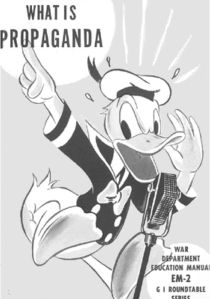prop·a·gan·da
[prop-uh-gan-duh]
noun
1. information, ideas, or rumors deliberately spread widely to help or harm a person, group, movement, institution, nation, etc.
2. the deliberate spreading of such information, rumors, etc.
3. the particular doctrines or principles propagated by an organization or movement.
What is Propaganda?
As opposed to information that is objectively presented to inform a audience, propaganda is constructed with the intent to influence the attitudes, beliefs, or opinions of a target audience. Richard Alan Nelson defines propaganda as such: “Propaganda is neutrally defined as a systematic form of purposeful persuasion that attempts to influence the emotions, attitudes, opinions, and actions of specified target audiences for ideological, political or commercial purposes through the controlled transmission of one-sided messages (which may or may not be factual) via mass and direct media channels” [1]. Propaganda is considered to be by popular opinion a wholly negative term, loosely considered to be a synonym for blatant lying and manipulative coercion. Settling on a universally agreed upon definition of propaganda has not been achieved ever since its coinage. Indeed, “The experts have plenty of trouble in agreeing upon a satisfactory definition of propaganda, but they are agreed that the term can’t be limited to the type of propaganda that seeks to achieve bad ends or to the form that makes use of deceitful methods” [2]. Various individuals and groups have attempted to pin down propaganda in one way or another. Some say that propaganda must have emotional appeal, but many things which most would consider propaganda are based purely in logic (just, perhaps, false logic). Some people assert that propaganda is present only in periods of controversial situations, but this is not the whole case because we widely regard things such as STD awareness as propaganda. Robert B. Townsend closes his examination of what propaganda is with the following remark: “Most students of the subject agree that propaganda has to do with any ideas and beliefs that are intentionally propagated. They agree also that it attempts to reach a goal by making use of words and word substitutes. Types of propaganda range from the selfish, deceitful, and subversive to the honest and aboveboard promotional effort. It can be concealed or open, emotional or containing appeals to reason, or a combination of emotional and logical appeals” [2].
The definition used for purposes here is: “Propaganda is information that deliberately attempts to persuade the attitudes, beliefs, or opinions of a target audience for ideological or political reasons”.
Types of Propaganda
There is a way in which propaganda is classified that is popular in propaganda studies, this is the black-white-gray classification. This classification system focuses primarily on the originator of the propaganda in question and its terms are as follows:
White Propaganda: Propaganda which truthfully states its origin (the source is outright identified). The information presented is accurate (even if one sided, etc.). It is the most common type of propaganda.
Gray Propaganda: Propaganda whose source may or may not be correctly identified. Accuracy of information is uncertain. “The objective of gray propaganda is to advance viewpoints that are in the interest of the originator but that would be more acceptable to target audiences than official statements. The reasoning is that avowedly propagandistic materials from a foreign government or identified propaganda agency might convince few, but the same ideas presented by seemingly neutral outlets would be more persuasive” [3].
Black Propaganda: Black propaganda, like gray, camouflages the true source of the propaganda. But while gray propaganda is unattributed, black propaganda is typically falsely attributed. “Black propaganda is highly subversive and provocative; it is usually designed to appear to have originated from a hostile source, in order to cause that source embarrassment, to damage its prestige, to undermine its credibility, or to get it to take actions that it might not otherwise” [3].
This classification of propaganda is not universally agreed upon and is not useful for our purposes here. These forms, in any significant sense, only account for the origination source of the propaganda and for the most part over look methods and intent of the source. These three forms of propaganda will be considered only so far as the originating source of the propaganda will be considered in light of the following categories.
Soft Propaganda:
- Most closely resembles “white propaganda”
- Source is known
- Information presented is largely accurate and truthful
- Seeks informed support from target audience
- Goal is to further the goals of the propagandist but not without regard to the well-being of the audience
Hard Propaganda:
- Most closely resembles “black propaganda”
- Source may be unclear or unknown
- Information presented is largely inaccurate, false or deceitful [4]
- Seeks to coerce its audience, rather that truthfully inform
- Goal is to further the goals of the propagandist, with no concern for well-being of the audience
- In general it does the following: calls on false authority, lies, fabricates, exaggerates, deceives, coerces, or disinforms.
The terms Soft Propaganda and Hard Propaganda will be used throughout this project as adjectives – not as exclusive classifications.
[1] Richard Alan Nelson, A Chronology and Glossary of Propaganda in the United States (1996) pp. 232-233
[2] http://www.historians.org/projects/giroundtable/Propaganda/Propaganda8.htm
[3] http://www.americanforeignrelations.com/O-W/Propaganda-Types-of-propaganda.html
[4] Jowett, Garth S., Garth Jowett, Victoria O’Donnell. 2006. Sage Publications, Thousand Oaks, California

